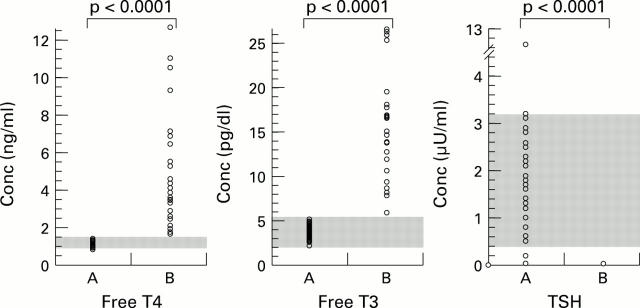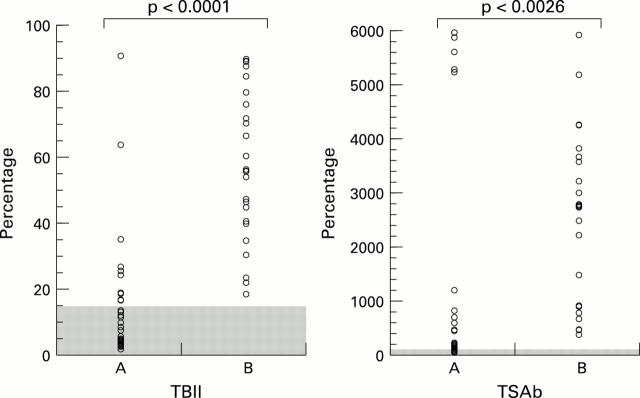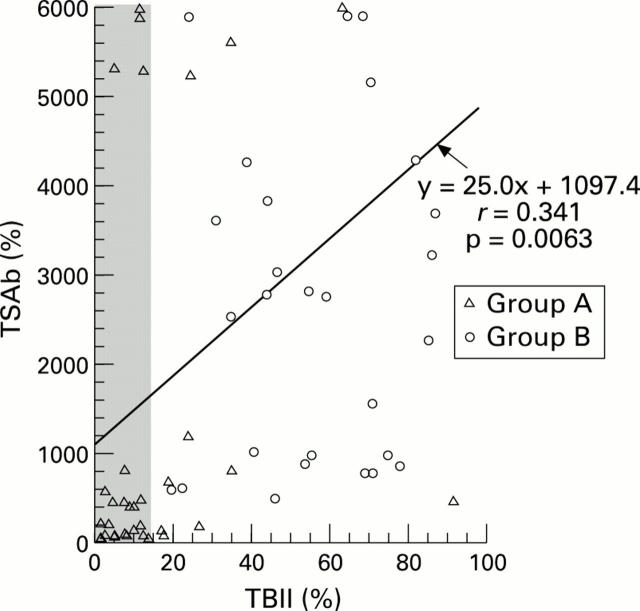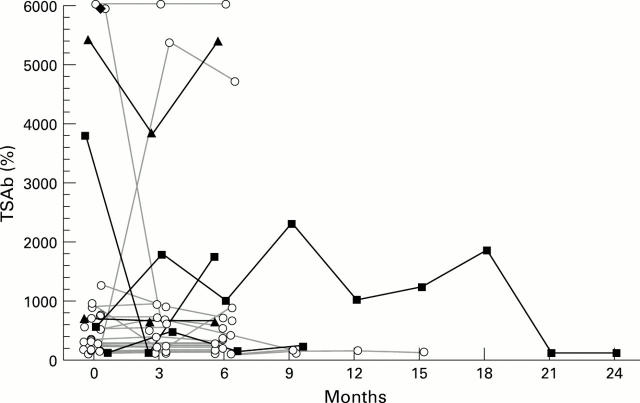Abstract
AIMS/BACKGROUND—Thyroid associated ophthalmopathy (TAO) of euthyroid patients is difficult to diagnose because clinical findings overlap with other conditions, and no confirmatory diagnostic tests are available. Recently, it was reported that TSH binding inhibitor immunoglobulin (TBII) and thyroid stimulating antibody (TSAb) are sensitive markers of TAO. The sensitivity of these antibodies in the detection of TAO were therefore studied to determine if they could be a useful criterion in the diagnosis of TAO of euthyroid patients. METHODS—Serum values of TBII and TSAb of 35 patients with euthyroid TAO (group A) were compared with those of 27 patients with Graves' disease and TAO (group B). The relation between the serum value of TSAb and the eye symptoms of patients with euthyroid TAO were also examined by multiple linear regression analysis. RESULTS—In group A, TBII was positive in 10 cases (28.6%) and TSAb was positive in 29 cases (82.9%). In group B, both TBII and TSAb were positive in all cases (100%). The titre of serum TBII in group A (15.6% (SD 18.0%)) was significantly lower (p<0.0001) than in group B (57.9% (21.5%)). The titre of serum TSAb in group A (1400.9% (2163.9%)) was significantly lower (p=0.0026) than in group B (2243.9% (1472.8%)). Among the eye findings of patients with euthyroid TAO, keratopathy was significantly (p=0.034) related to the value of TSAb. CONCLUSION—These results suggest that the activity of TSAb is a more sensitive marker of euthyroid TAO than is TBII, and could be a useful criterion in the diagnosis of TAO of euthyroid patients.
Full Text
The Full Text of this article is available as a PDF (125.0 KB).
Figure 1 .
Serum value of free T4, T3, and TSH in group A (euthyroid patients with thyroid associated ophthalmopathy) and in group B (patients with Graves' disease and ophthalmopathy). The shaded area indicates the normal range.
Figure 2 .
Serum value of TBII and TSAb in groups A and B. The shaded area indicates the normal range.
Figure 3 .
Relation between serum value of TSAb and TBII in both groups. The linear regression analysis has been done on the combined data from group A and B.
Figure 4 .
Change in serum value of TSAb in group A. The follow up period was from 6 to 21 months. (∘ euthyroid throughout the follow up period, ▪, became hyperthyroid, ▴, developed Hashimoto's disease, ♦, adenocarcinoma of thyroid was diagnosed.)
Selected References
These references are in PubMed. This may not be the complete list of references from this article.
- Ambesi-Impiombato F. S., Parks L. A., Coon H. G. Culture of hormone-dependent functional epithelial cells from rat thyroids. Proc Natl Acad Sci U S A. 1980 Jun;77(6):3455–3459. doi: 10.1073/pnas.77.6.3455. [DOI] [PMC free article] [PubMed] [Google Scholar]
- Amino N., Yuasa T., Yabu Y., Miyai K., Kumahara Y. Exophthalmos in autoimmune thyroid disease. J Clin Endocrinol Metab. 1980 Dec;51(6):1232–1234. doi: 10.1210/jcem-51-6-1232. [DOI] [PubMed] [Google Scholar]
- Bartley G. B., Gorman C. A. Diagnostic criteria for Graves' ophthalmopathy. Am J Ophthalmol. 1995 Jun;119(6):792–795. doi: 10.1016/s0002-9394(14)72787-4. [DOI] [PubMed] [Google Scholar]
- Bíró J. Thyroid-stimulating antibodies in Grave's disease and the effect of thyrotrophin-binding globulins on their determination. J Endocrinol. 1982 Feb;92(2):175–184. doi: 10.1677/joe.0.0920175. [DOI] [PubMed] [Google Scholar]
- Feliciello A., Porcellini A., Ciullo I., Bonavolontà G., Avvedimento E. V., Fenzi G. Expression of thyrotropin-receptor mRNA in healthy and Graves' disease retro-orbital tissue. Lancet. 1993 Aug 7;342(8867):337–338. doi: 10.1016/0140-6736(93)91475-2. [DOI] [PubMed] [Google Scholar]
- Kasagi K., Hatabu H., Tokuda Y., Arai K., Iida Y., Konishi J. Comparison of thyroid stimulating activities measured by cyclic AMP production, those by radioiodine uptake in FRTL-5 cells and TSH-binding inhibitory activities in patients with hyperthyroid and euthyroid Graves' diseases. Acta Endocrinol (Copenh) 1988 Mar;117(3):365–372. doi: 10.1530/acta.0.1170365. [DOI] [PubMed] [Google Scholar]
- Kasagi K., Hatabu H., Tokuda Y., Iida Y., Endo K., Konishi J. Studies on thyrotrophin receptor antibodies in patients with euthyroid Graves' disease. Clin Endocrinol (Oxf) 1988 Oct;29(4):357–366. doi: 10.1111/j.1365-2265.1988.tb02884.x. [DOI] [PubMed] [Google Scholar]
- Kosugi S., Inoue D., Sugawa H., Enomoto T., Mori T., Imura H. Similarity and dissimilarity between clinical and laboratory findings, especially anti-thyrotropin receptor antibody in ophthalmic Graves' disease without persistent hyperthyroidism and hyperthyroid Graves' disease. Endocrinol Jpn. 1990 Jun;37(3):343–354. doi: 10.1507/endocrj1954.37.343. [DOI] [PubMed] [Google Scholar]
- Liddle G. W., Heyssel R. M., McKenzie J. M. Graves' disease without hyperthyroidism. Am J Med. 1965 Nov;39(5):845–848. doi: 10.1016/0002-9343(65)90104-x. [DOI] [PubMed] [Google Scholar]
- Ludgate M. E., Vassart G. The thyrotropin receptor as a model to illustrate receptor and receptor antibody diseases. Baillieres Clin Endocrinol Metab. 1995 Jan;9(1):95–113. doi: 10.1016/s0950-351x(95)80851-5. [DOI] [PubMed] [Google Scholar]
- Macchia E., Fenzi G. F., Monzani F., Lippi F., Vitti P., Grasso L., Bartalena L., Baschieri L., Pinchera A. Comparison between thyroid stimulating and tsh-binding inhibiting immunoglobulins of Graves' disease. Clin Endocrinol (Oxf) 1981 Aug;15(2):175–182. doi: 10.1111/j.1365-2265.1981.tb00652.x. [DOI] [PubMed] [Google Scholar]
- McLachlan S. M., Bahn R., Rapoport B. Endocrine ophthalmopathy: a re-evaluation of the association with thyroid autoantibodies. Autoimmunity. 1992;14(2):143–148. doi: 10.3109/08916939209083133. [DOI] [PubMed] [Google Scholar]
- Perros P., Kendall-Taylor P. Demonstration of thyrotropin binding sites in orbital connective tissue: possible role in the pathogenesis of thyroid-associated ophthalmopathy. J Endocrinol Invest. 1994 Mar;17(3):163–170. doi: 10.1007/BF03347708. [DOI] [PubMed] [Google Scholar]
- Perros P., Kendall-Taylor P. Thyroid-associated ophthalmopathy: pathogenesis and clinical management. Baillieres Clin Endocrinol Metab. 1995 Jan;9(1):115–135. doi: 10.1016/s0950-351x(95)80867-1. [DOI] [PubMed] [Google Scholar]
- Salvi M., Zhang Z. G., Haegert D., Woo M., Liberman A., Cadarso L., Wall J. R. Patients with endocrine ophthalmopathy not associated with overt thyroid disease have multiple thyroid immunological abnormalities. J Clin Endocrinol Metab. 1990 Jan;70(1):89–94. doi: 10.1210/jcem-70-1-89. [DOI] [PubMed] [Google Scholar]
- Shewring G., Smith B. R. An improved radioreceptor assay for TSH receptor antibodies. Clin Endocrinol (Oxf) 1982 Oct;17(4):409–417. doi: 10.1111/j.1365-2265.1982.tb01607.x. [DOI] [PubMed] [Google Scholar]
- Southgate K., Creagh F., Teece M., Kingswood C., Rees Smith B. A receptor assay for the measurement of TSH receptor antibodies in unextracted serum. Clin Endocrinol (Oxf) 1984 May;20(5):539–548. doi: 10.1111/j.1365-2265.1984.tb00102.x. [DOI] [PubMed] [Google Scholar]
- Sugenoya A., Kidd A., Row V. V., Volpé R. Correlation between thyrotropin-displacing activity and human thyroid-stimulating activity by immunoglobulins from patients with Graves' disease and other thyroid disorders. J Clin Endocrinol Metab. 1979 Mar;48(3):398–402. doi: 10.1210/jcem-48-3-398. [DOI] [PubMed] [Google Scholar]
- Tamaki H., Amino N., Aozasa M., Mori M., Tanizawa O., Miyai K. Serial changes in thyroid-stimulating antibody and thyrotropin binding inhibitor immunoglobulin at the time of postpartum occurrence of thyrotoxicosis in Graves' disease. J Clin Endocrinol Metab. 1987 Aug;65(2):324–330. doi: 10.1210/jcem-65-2-324. [DOI] [PubMed] [Google Scholar]
- Tamaki H., Amino N., Iwatani Y., Miyai K. Improvement of infiltrative ophthalmopathy in parallel with decrease of thyroid-stimulating antibody (TSAb) activity in two patients with hypothyroid Graves' disease. J Endocrinol Invest. 1989 Jan;12(1):47–53. doi: 10.1007/BF03349918. [DOI] [PubMed] [Google Scholar]
- Werner S. C. Modification of the classification of the eye changes of Graves' disease: recommendations of the Ad Hoc Committee of the American Thyroid Association. J Clin Endocrinol Metab. 1977 Jan;44(1):203–204. doi: 10.1210/jcem-44-1-203. [DOI] [PubMed] [Google Scholar]






